Social Media Advertising: Exploring the Different Types and Their Uses
In the early days of the internet, simply creating a website was enough to establish your digital presence. Then came the social media era. Hence setting up a profile on popular social media platforms became essential to complete a brand’s digital presence. Today, almost every business, regardless of size or location, has both a website and a social media presence. So, how do you stand out in a crowded digital landscape? The answer lies in social media advertising.

Social media advertising allows you to go beyond organic reach by investing in targeted campaigns that ensure your content gets noticed. It’s about putting in the extra effort and allocating a budget to increase your brand’s visibility and engagement.
And the truth is, the benefits of social media advertising don’t end there. So, how can you leverage these advantages for your brand? In this blog, we’ll explore the most popular and profitable types of social media ads that brands are investing in, and why you should consider them too.
Key Social Media Advertising Statistics
Let’s start by exploring the current scenario in the social media advertising realm to know what you are missing out on by not investing in it and what to expect when you do start investing in it.
- The total global social media advertising spend is projected to grow from 234.14 billion U.S. dollars in 2024 to about 345 billion dollars in the year 2029. Therefore, marketers are not just spending on social media ads but also continuously expanding their spending consistently.
- According to some studies, the ROI of social media ads can go up to a whopping 250%. And YouTube happens to be the best platform in terms of ROI. So, for businesses looking to reap maximum benefits from minimum spending, social media advertising is definitely a profitable option to consider.
- Moreover, social media advertising seems to be occupying a huge chunk of the digital advertising landscape with about 28.8% of the total digital ad spending coming from social media ads.
- When it comes to the benefits of spending on social media advertising, different marketers have different opinions. About 83% of them report an increase in exposure as one of the main benefits they look out for. And several others talk about traffic boosts and lead generation as the other main advantages of creating social media ads.
- Statista states that in 2028, about 255.8 billion U.S. dollars will be the total ad spending on social media advertising through mobile devices alone.
To tap into all these benefits of social media advertising, you need to know the different types and where to use them.
4 Types of Social Media Ads Every Brand Needs
1. Single-Image ads
Where can you use them?
Single-image ads are the most versatile in social media advertising since almost all social media platforms support this type.
For instance, LinkedIn supports single-image ads in both Classic and Accelerate campaigns. On the other hand, Meta supports diverse placements for single-image ads on Facebook, Instagram, Messenger, and Audience Network as well.
Pinterest, X, and Snapchat also support single-image ads
Why should you use them?
Across all these platforms, you can use single-image ads to:
- Generate leads
- Drive traffic to your website
- Increase brand awareness
- Boost engagement
In addition to all these benefits, single-image ads are easy to create and can appear native to the chosen platform. For instance, notice how the below ad fits seamlessly into the X Feed looking like just another post therefore combating issues like banner-blindness which prevents people from even looking at your ads.
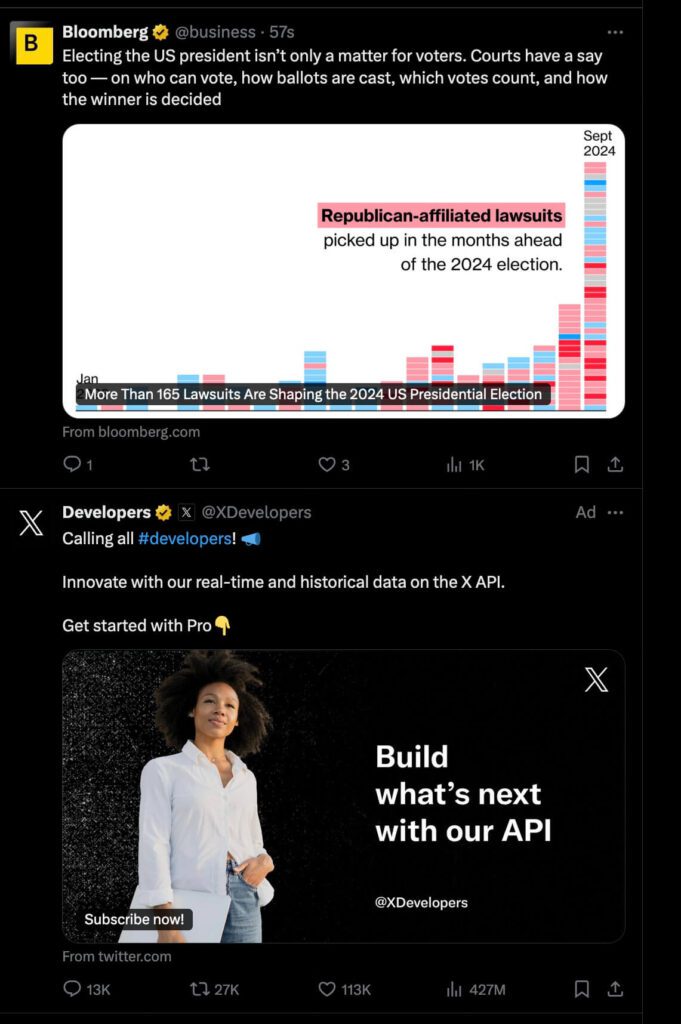
Tips to make single-image ads work
The first and foremost tip to make social media advertising work, irrespective of the format, is to double-check the platform specifications and stick to them. In addition to that here are a few more tips to remember.
Use text wisely. You do not want too much text crowding the little space or too little text that fails to deliver the message. To amplify the effect of the text in your image ads, state the value proposition or use numbers as in the LinkedIn ad here. This way you get straight to the point and therefore increase the chances of conversion.
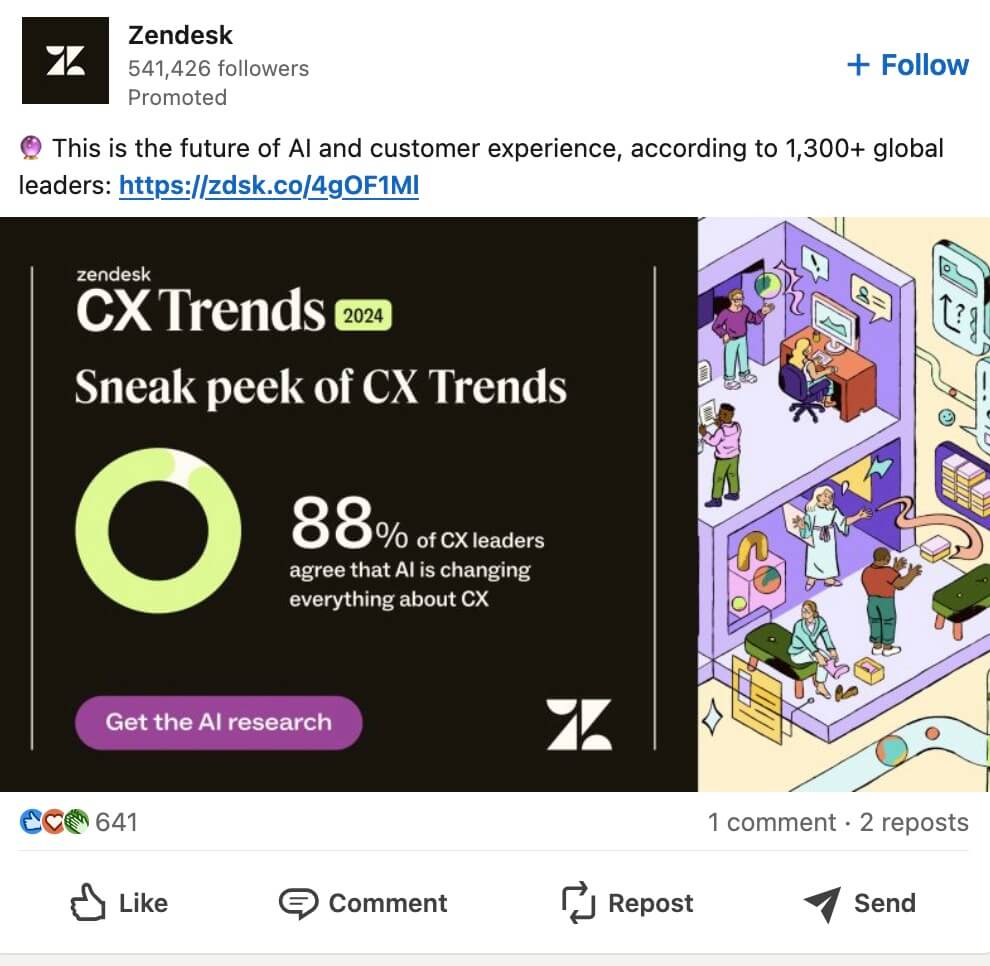
Prioritize the use of relevant high-quality visuals. Authentic lifestyle photos and photos of people look more natural on social media, particularly for consumer-focused brands. The below Facebook ads from Amazon exemplify this.
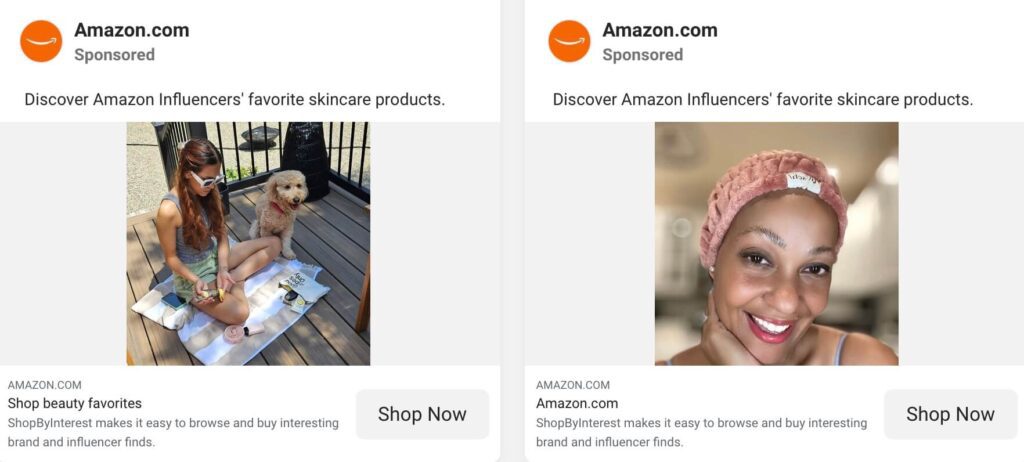
Finally, ensure that your single-image ad has a clear hierarchy leading seamlessly to the CTA. Also, use contrasting colors and a prominent font size to make your CTA stand out. Here’s an example.

2. Carousel Ads
Where can you use them?
Carousel ads are popular in social media advertising because they instantly invite customers to interact with them. Carousel ads present customers with a series of images or videos to swipe through in order to get the big picture.
Unlike single-image ads, carousel ads are only supported on a few platforms and each has its own rules. For instance, LinkedIn supports only images in carousel ads. Whereas, Facebook, Instagram, and X support both images and videos.
On Snapchat, you have Collection Ads that support both image and video slideshows, instead of the traditional carousel ad format.
Why should you use them?
The transition from one slide to the next in carousel ads allows advertisers to present users with an immersive story to follow through. This helps create an air of intrigue when presenting a problem and its solution or before/after images to give a demonstration of the value you create.
Carousel ads are also handy in introducing new products. Each slide can be used to highlight one particular feature. Walmart’s Facebook ad here does this beautifully.
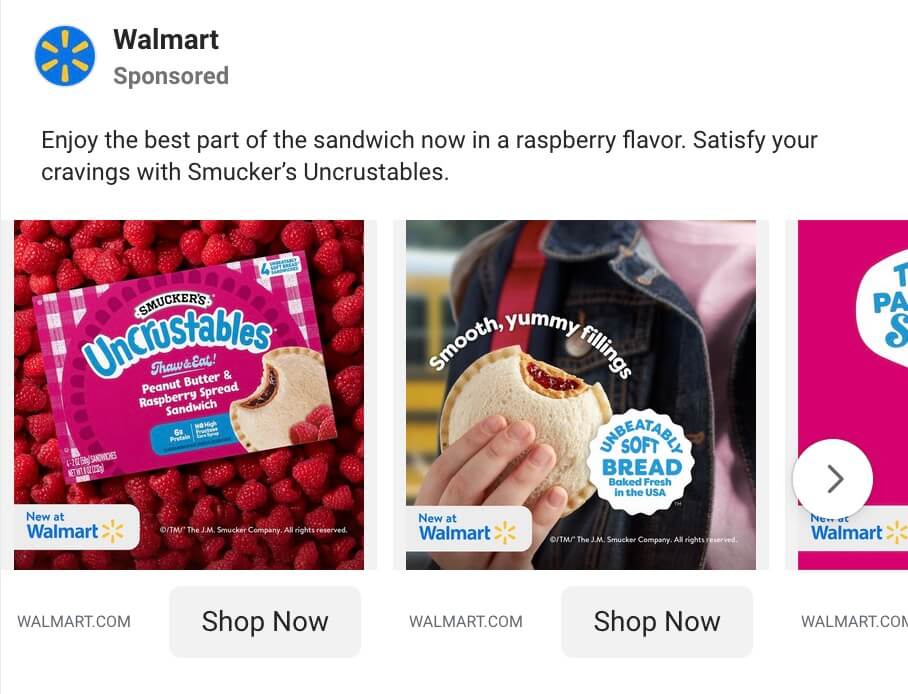
In short, if you wish to tap into social media advertising to tell your brand story or to shine the spotlight on a new product or even build trust by presenting customer stories, then carousel ads are a great option.
Tips to make carousel ads work
Depending on the purpose of the ad, add the same or different links and CTAs to each slide in your image. However, similar to image ads, keep text to a minimum and use engaging visuals to communicate your message clearly without overwhelming the audience. The crisp text in the below LinkedIn carousel ad makes it easy to navigate through.
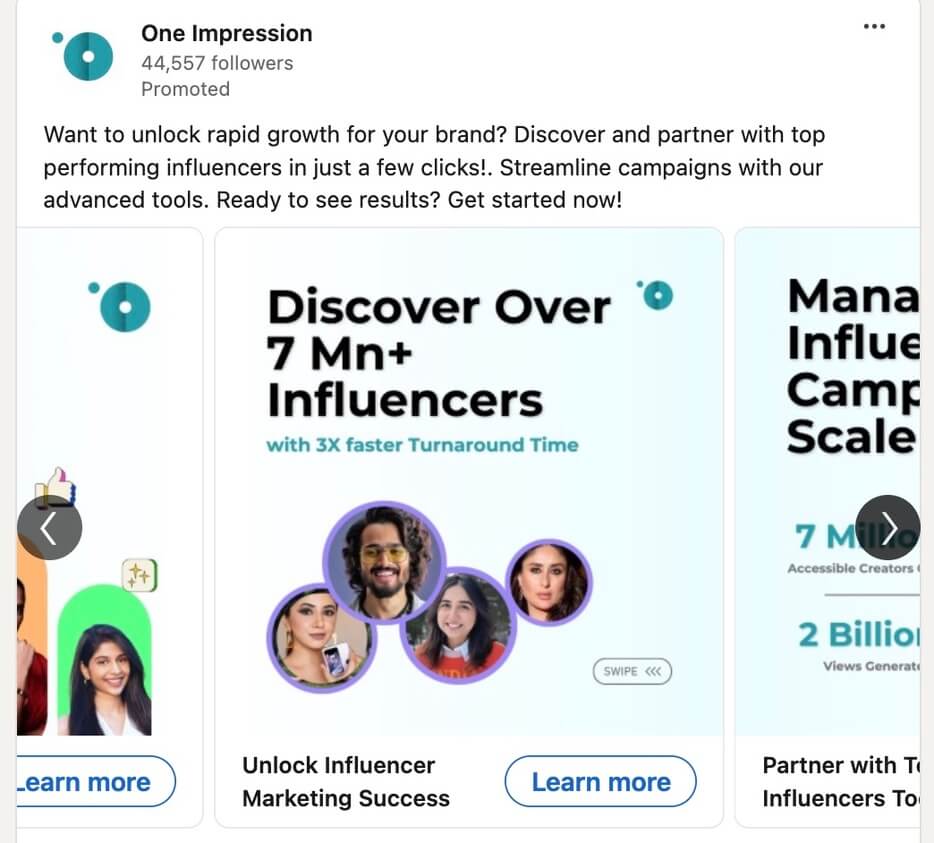
Secondly, ensure visual consistency between your slides. If the slides all look and feel different, they do not harmoniously lead the users to the next slide. Moreover, inconsistencies in visual styles might also end up confusing your customers as well. Here’s an example of how visually delightful a cohesive style in carousels can be.

Ensure sequential presentation and an instantly recognizable connection between your slides and the ad description text. They should all work synchronously to present the core message. The Facebook carousel here from Cadbury achieves that with minimal text and brilliant use of social media lingo as well.
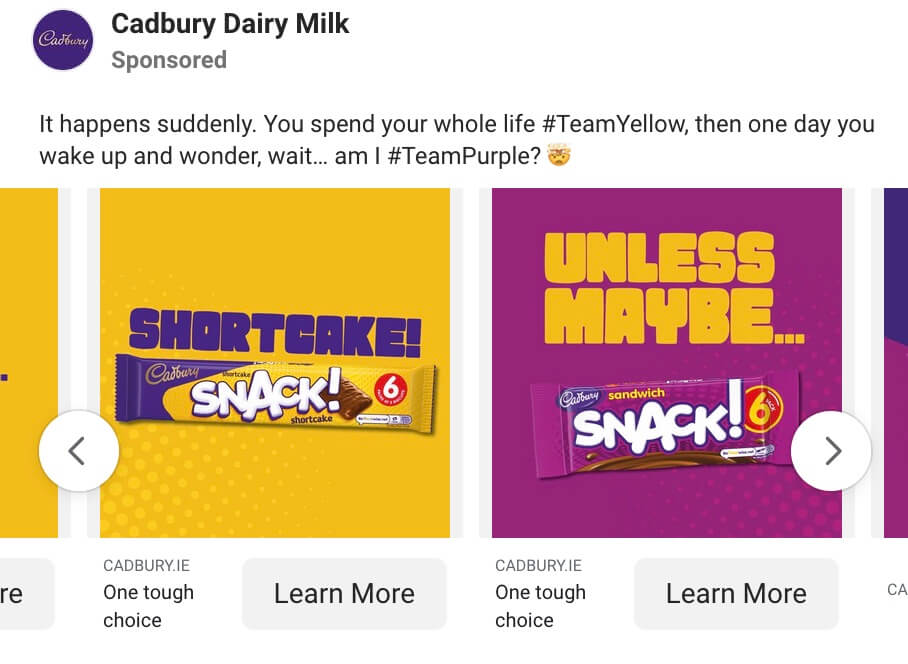
3. Video Ads
Where can you use them?
Now let’s talk about one of the most successful and perhaps one of the most favored ad types in social media advertising – video ads. Given that about 90% of consumers expect to see more videos from brands on social media, video ads make perfect sense.
Moreover, more and more platforms are now prioritizing video content like the push for videos on X, the updated video feed introduced on LinkedIn, and so on.
One of the main reasons to consider investing in video ads is that most social media platforms allow multiple placements for videos. For instance, Facebook lets video ads appear in the Feed, on Stories, and in-stream. But keep in mind, Facebook supports videos up to 2 minutes long whereas Instagram supports videos up to 1 minute long.
Video ads also work well on YouTube, TikTok, Snapchat and LinkedIn.
Why should you use them?
Video ads let you include product demos and intro videos that introduce a product or its unique features to your target customers. Additionally, video ads let you amplify your social media advertising efforts by collaborating with actual customers or influencers to talk about these features and thus deliver some fresh perspectives. Like the BMW Facebook ad here.
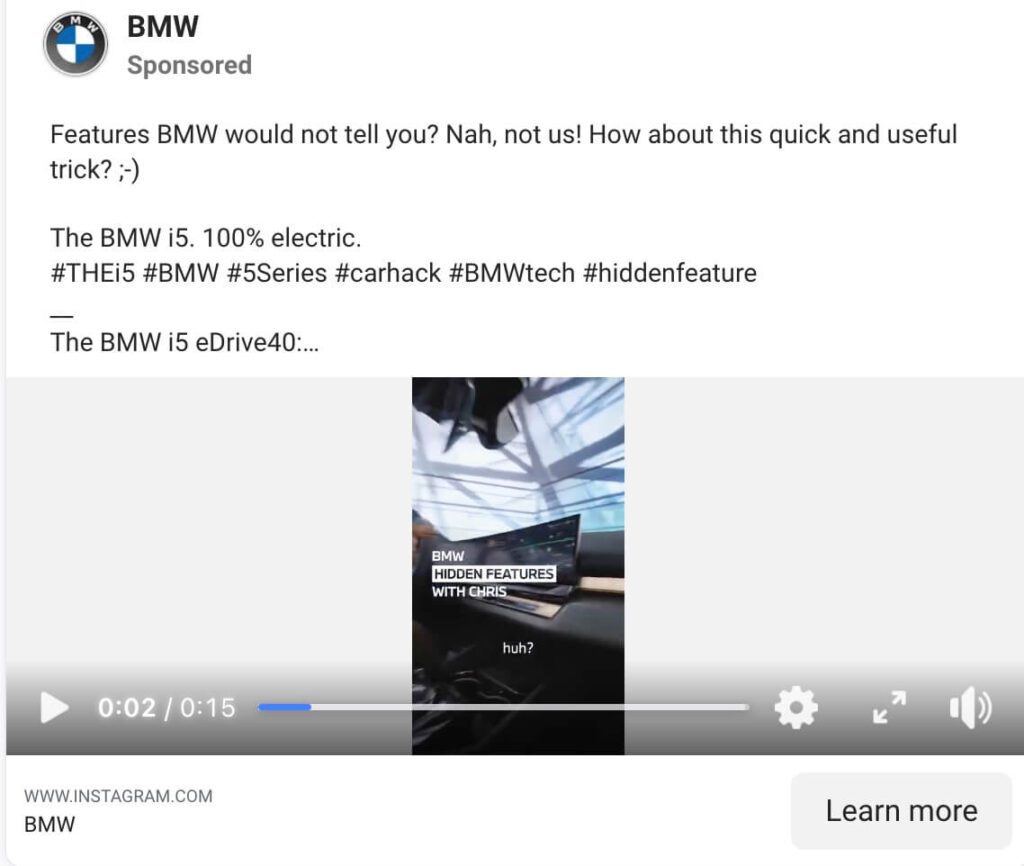
Videos are engaging and they work effectively in delivering even the most complicated messages in just a few seconds. Therefore there is a better chance of conversion with videos. Moreover, videos are also known for their easy shareability which in turn elevates your brand’s visibility.
Tips to make video ads work
Irrespective of the platform and placement, try and keep your video ads as short as possible. Because data shows that about 35% of marketers find short-form videos to be some of the best options in social media advertising, in terms of ROI.
The first few seconds matter the most. So, build credibility through relevant data and facts. Or better yet, add a catchy hook that makes your video appear instantly relatable to your customers.
Infographics and other interactive formats like the one used in the video ad here can add more value to your content and make it easier to connect with.
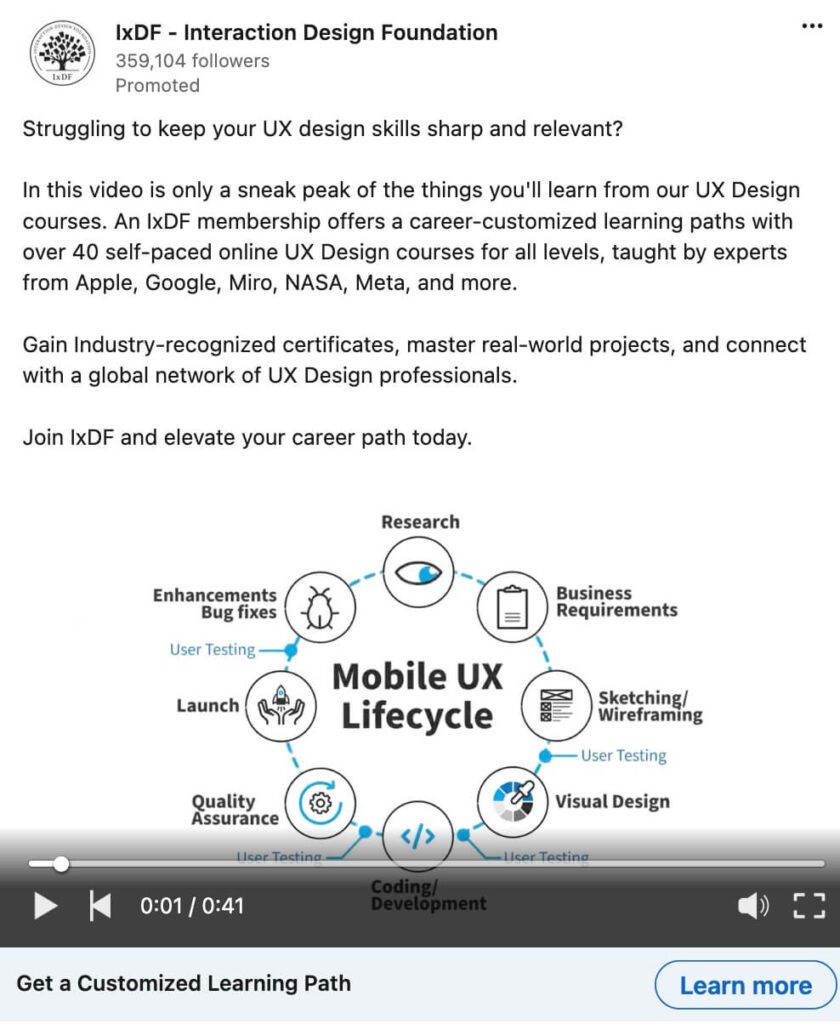
4. Story Ads
Where can you use them?
If there is one form of social media advertising that prioritizes mobile users it’s Story ads. Story posts are engaging ephemeral posts appearing on Facebook and Instagram. And they are a great way to provide your customers with instant updates. Extrapolating this idea to ads, Story ads work by tapping into the endless and effortless swipes it takes for users to go from one post to the next.
Story Ads are also great for brands looking to focus on the younger crowd through Snapchat and on TikTok as well.
Why should you use them?
Story ads take up the entire mobile screen and hence are immersive and visually appealing. This also means that they appear sans distractions on the screen in the case of other social media advertising formats.
Given the quick reach and temporary nature of Story ads, they are great for announcing flash sales and limited-time deals that need to instantly attract attention and encourage immediate action.
One of the biggest perks of social media advertising is that it is versatile. And Story ads exemplify this versatility. Because you can use single images, carousels, single videos, a carousel of videos, GIFs, and so much more on Story ads.
Tips to make Story ads work
Simplify your message. Identify a single solid response from your customer and ensure that your Story ad clearly communicates this message to evoke an instant response. Like the Story post here.

Prioritize readability when making typography decisions. Given that Story ads are fleeting, you need minimal text presented in a legible font. And of course, with good contrast between the background and foreground. All of these put together deliver the message effectively without requiring the user to hold the Story or make an effort to comprehend the message.
Here’s an example where the brand uses big bold text that makes for a scroll-stopping Story ad design.

Use high-quality relevant visuals to immediately attract attention. For instance, moving stills in the background and stationery text in the foreground enhances the visual appeal of your Story ads.

When you do use expandable Story ads or carousels of images or videos keep them short and seamlessly connected. Like traditional carousel posts, there should be a visual consistency across the media files, a streamlined portrayal of the main message, and a hierarchical presentation of the CTA.
In addition to all these strategies, remember to use the Swipe Up feature on Instagram and other interactive elements like stickers, interactive polls, and more. These encourage customers to interact with your post and simplify their efforts as well.
Other Social Media Advertising Options
Besides the above four ad types, here are some more options to explore when investing in social media advertising:
Promoted posts:
Promoted posts are regular posts that you can pay to boost in order to reach a larger audience. In other words, to reach the Feeds of users who do not already follow your account on social media.
Working well on platforms like Instagram, LinkedIn, Facebook, and X, these are effective in boosting the reach for crucial promotions and business announcements.
Influencer sponsored content:
Sponsored videos or influencer ads involve partnering with social media influencers to promote your product or service. These are great options to reach your target audience and enhance your brand’s credibility by building on the trust and influence the influencer has over their followers.
Messenger ads:
Available particularly on Instagram and Facebook, these are ads that allow businesses to directly engage with their customers through chat. This can therefore be quite useful in personalized marketing.
Give Your Social Media Advertising Effort a Boost With KIMP Designs
As you can see, there are plenty of options both in terms of formats and placements in social media advertising. And there are ad types for every budget and marketing goal as well. Hence, it’s all about making the most of that chance you grab. Given the need for a strong first impression, you cannot let poorly designed visuals let your business down.
You need designs that do not just look stunning but also effectively deliver your message and preserve your brand’s identity. One way to ensure this is by working with a dedicated design team that consistently crafts all your marketing visuals and regular social media designs and other graphics. That’s precisely what an unlimited design service like KIMP offers.
Register now for a 7-day free trial!
